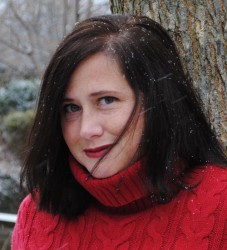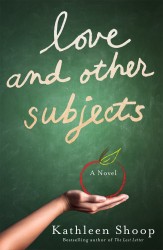By Kathleen Shoop
My favorite part of reading books and watching movies is experiencing richly layered characters. So when I write, I try to develop “real people” who make the reader react—whether it’s with affection, disdain or something altogether different. I hope my characters never appear flat or stereotypical. In fact, avoiding stereotypical characters was never more important than in writing Love and Other Subjects, where many of the characters are African American—a race and culture different from the ones in which I grew up.
When I think of characters rich in cultural nuances, the books Memoirs of a Geisha by Arthur Golden and The Help by Kathryn Stockett instantly come to mind. As a man from Tennessee, Golden could not have been further from his characters’ culture. Yet the novel is every bit the essence of a woman living within exotic and old-fashioned social structures he couldn’t have possibly ever known for himself.
The Help is widely known for its authenticity. Stockett grew up in an affluent community similar to the one she portrayed in the book. In addition to writing characters that reflected that affluence, she wrote about black maids whose “voices” were drawn from women who were deeply embedded in her upbringing. In the book, these working-class and affluent characters moved around each other like oil and water: combining in ways that were meaningful, but at the end of a workday they separated, assimilating back into their own neighborhoods and social lives. She was masterful at joining the two worlds for readers to relish.
Striking a balance
In writing Love and Other Subjects, my task was similar to Stockett’s. I needed to bring to life the drama of urban education in a way that readers would learn from it, as well as enjoy reading. One way to do that was to give the novel the common experience of fun, post-college life many young women share: the malleable state that friendships occupy during that period of time, changing as individual women do. Along those lines come love, engagements and pregnancies.
At the same time, Love and Other Subjects needed to show the hardships of education in urban settings. Hence, I had to strike a balance between light, entertaining plots and issues-oriented classroom drama that didn’t peddle stereotypes.
Much of what happens in the main character Carolyn’s personal life and among her colleagues is satirical and exaggerated, as fiction often is. But the children in her classroom needed to be as unexaggerated as possible, and I needed to be sure I wasn’t careless with their portrayal.
Keeping it real
When it came to keeping every character both multi-faceted and real, I relied on my own experience. For over twenty years, I’ve worked in urban classrooms around the country, conducted ethnographic research, and studied the way people use text in all areas of their lives—home, school, church, and with friends. In many ways, it was as easy to pull conversations, snapshots and drama right from my experiences in the classroom as it was to craft fictional, personal plots for each character.
But as I hunkered down for a very specialized round of editing, I wanted to be sure I was purposeful in molding those characters who were not a reflection of my upbringing, the way middle-class, white, Carolyn was.
I took a “surgical-editing” approach to be sure there were distinct illustrations of Terri, one of Carolyn’s African American students. I showed Terri’s high intelligence (though often hidden when it suited her “goals”) through her deliberate code-switching between “book language” and “neighborhood language” at the drop of an insult. I wanted to be sure the subtle, though enormous differences in the way students with parents who pushed education (even if they were also poor) spoke and thought were evident. My goal was for every child’s “voice” and dreams to be as different as he or she looked.
For example, Terri’s clicking beads were contrasted by Yvette’s tight bun. These features were introduced as a means to develop who these girls were—their hair figured into their characters or plot as much as the words they used.
Staying true to the subject matter
I looked for places where I might have been lazy with characterizations that could be construed as sloppy or stereotypical. Did I really represent the multi-hued, multi-faceted children in that classroom in a way that allowed me to fictionalize the experience, but stay true to one particular moment in one particular “teacher’s” life?
As I conducted this special edit, I began to think that writing what I knew (or, what I thought I knew) was harder than writing about places and times I’d never experienced. Pulling from real life is powerful because it lends the work authenticity, but in some ways it’s more work. Like a contractor would say, it’s easier to build a new house than reconstruct one that’s already standing.
I worked hard to bring the voices and lives of kids who struggle to succeed in school to the pages of my book in a respectful way. I was prudent and resolute in joining what I know to be true from experience, formal research and anecdotes, with the fictional demands that a novel requires. For the reader, my goal was to create rich, magnetic characters. I hope this story is both fun and heartwarming and that it reveals the complications and joys that are inseparable in the pursuit of educating other people’s children.
About Kathleen Shoop

 Kathleen Shoop holds a PhD in reading education and has more than 20 years of experience in the classroom. Her first novel, The Last Letter, is a Kindle bestseller and multiple-award winner, including a Gold Medal in the Independent Publisher Book Awards. Her second novel, After the Fog, won a Silver the following year. She is featured in the Writer’s Guide to 2013. Her work has appeared in The Tribune-Review, four Chicken Soup for the Soul books and Pittsburgh Parent magazine. She lives in Oakmont, Pennsylvania with her husband and two children. Love and Other Subjects is her women’s fiction debut. Visit Kathleen at www.kshoop.com.
Kathleen Shoop holds a PhD in reading education and has more than 20 years of experience in the classroom. Her first novel, The Last Letter, is a Kindle bestseller and multiple-award winner, including a Gold Medal in the Independent Publisher Book Awards. Her second novel, After the Fog, won a Silver the following year. She is featured in the Writer’s Guide to 2013. Her work has appeared in The Tribune-Review, four Chicken Soup for the Soul books and Pittsburgh Parent magazine. She lives in Oakmont, Pennsylvania with her husband and two children. Love and Other Subjects is her women’s fiction debut. Visit Kathleen at www.kshoop.com.

